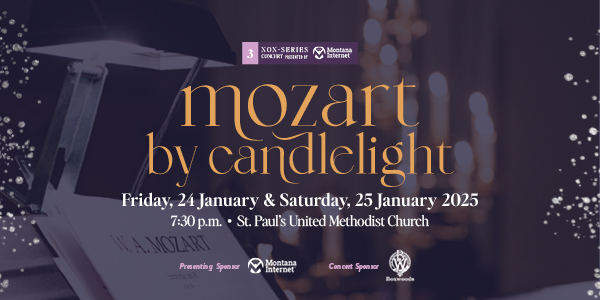An overture and a symphony by Mozart are paired with Beethoven’s witty and cheerful Fourth Symphony – and all bycandlelight.
Mozart by Candlelight is presented thanks to Montana Internet and Boxwoods Fine Homes & Lifestyles
OVERTURE TO LA CLEMENZA DI TITO
Mozart’s final year of his life was one of his busiest and most productive. In addition to his famous and unfinished Requiem, healso composed the operas Die Zauberflöte (The Magic Flute) and La Clemenza di Tito (The Clemency of Tito). While the commission forLa Clemenza di Tito was to honor the coronation of Emperor Leopold II as King of Bohemia, the opera had a mediocre reception, and perhaps was a work that took away time from the other two compositions.
Under pressure to produce the opera quickly, Mozart composed La Clemenza di Tito in less than three weeks, and often in carriages and inns on the way to Prague. This was very quick even for Mozart, and perhaps why it seems a bit stiff.
The story itself is borrowed from another opera composed a half century before. Set in 80 A.D., the opera revolves around the wise and benevolent Roman Emperor Titus and his extraordinarily generous clemency of his enemies who sought to assassinate him. As a Freemason, Mozart admired the Enlightenment virtue of clemency.
“The music of the opera is full of Mozart’s brilliance and original ideas that is the hallmark of his writing, including vivid, complexcharacters. While the Overture is completely devoid of themes from the opera itself, it does set a noble tone to suggest the Roman monarch (as well as alluding to the coronation of the new Austrian king),” explains Maestro Scott. “The Overture nicely sets up the drama that is about to ensure, complete with Bach-like counterpoint and Romantic-era colors, along with an intensity enhanced by the clarinets (a relatively new instrument in the orchestra).”
The Overture to La Clemenza di Tito seems closely linked to the Overture to The Magic Flute which was composed within a few days after the former. The opera premiered the first week in September 1791, some three months before Mozart’s brief life mysteriously ended.
Symphony No. 4 in B-flat major
Sandwiched between two of Beethoven’s most important works (the Third and Fifth Symphonies) the Symphony No. 4 is one of Beethoven’s more playful works. After the publication of the Third Symphony, Beethoven began working on what is today theFifth Symphony; however, due to a hectic schedule he put aside the project to finish his Violin Concerto, three Razumovsky String Quartets, and the final revisions of his opera, Fidelio.
While visiting one of his patrons, Beethoven met Count Franz Oppersdorf who offered the composer 500 florins for a new symphony.It is probable, but not certain, that the Count’s private orchestra gave the first public premiere of the Fourth Symphony, and the work was dedicated to the Count (as well as the Fifth Symphony).
“Part of Beethoven’s rarely seen sense of humor was a love of creating false expectations,” says Maestro Scott. “The opening of the Symphony is just that – a seemingly heavy, gloomy opening that seems to want to lead to another intense work; yet, the upbeat tempowill convey a light-hearted composition, full of joy. Throughout the movement Beethoven offers musical quirks using displaced accents, and sudden dynamic shifts to convey a light-hearted and lively mood. The traditional slower second movement tends to possess an inner glow with a steady rhythmic pulse and is one of the most beautifully constructed melodies that Beethoven ever wrote. The Menuetto of the third movement really is a rustic scherzo (a faster and more playful dance in a fast three, instead of the stately traditional minuet). It wanders far from the standard minuet / scherzo structure as well, as the rambunctious opening and the languid central trio sections come round over and over in playful succession. The finale, an exhilarating exercise in forward-pressing perpetual motion, surpasses any finale that precedes it due to its sheer excitement and spirited energy.”
Sir George Grove sums up Beethoven’s Fourth Symphony best by saying with the Fourth “we have a humor, a poetry, a pathos, a romance, and a maturity of style” that has few precedents.
~
Other Season 70 highlights coming up in 2025 includes Vaughan William’s Sea Symphony, the return of renowned Pianist
Roman Rabinovich, and Beethoven’s immortal Emperor Piano Concerto with noted Pianist Rodolfo Leone! Season 70 also
includes several free Symphony Kids Concerts and a black-tie Masquerade in June!
Season tickets for the remaining concerts of the Masterworks Series presented by AARP Montana are available at a reduced
rate. In addition to the substantial discounts on season tickets, subscribers also receive the Bring A Friend Pass, The Art of
Listening Newsletter, and several other benefits. Single concert tickets can also be purchased online at
www.helenasymphony.org, by calling the Symphony Box Office (406.442.1860), or visiting the Symphony Box Office
located on the Walking Mall at the Placer Building (21 N. Last Chance Gulch, Suite 100) between 10 a.m. and 4 p.m.
END.
Maestro Scott and guest artists are available for interviews by contacting
the Symphony at 406.442.1860 or [email protected]

